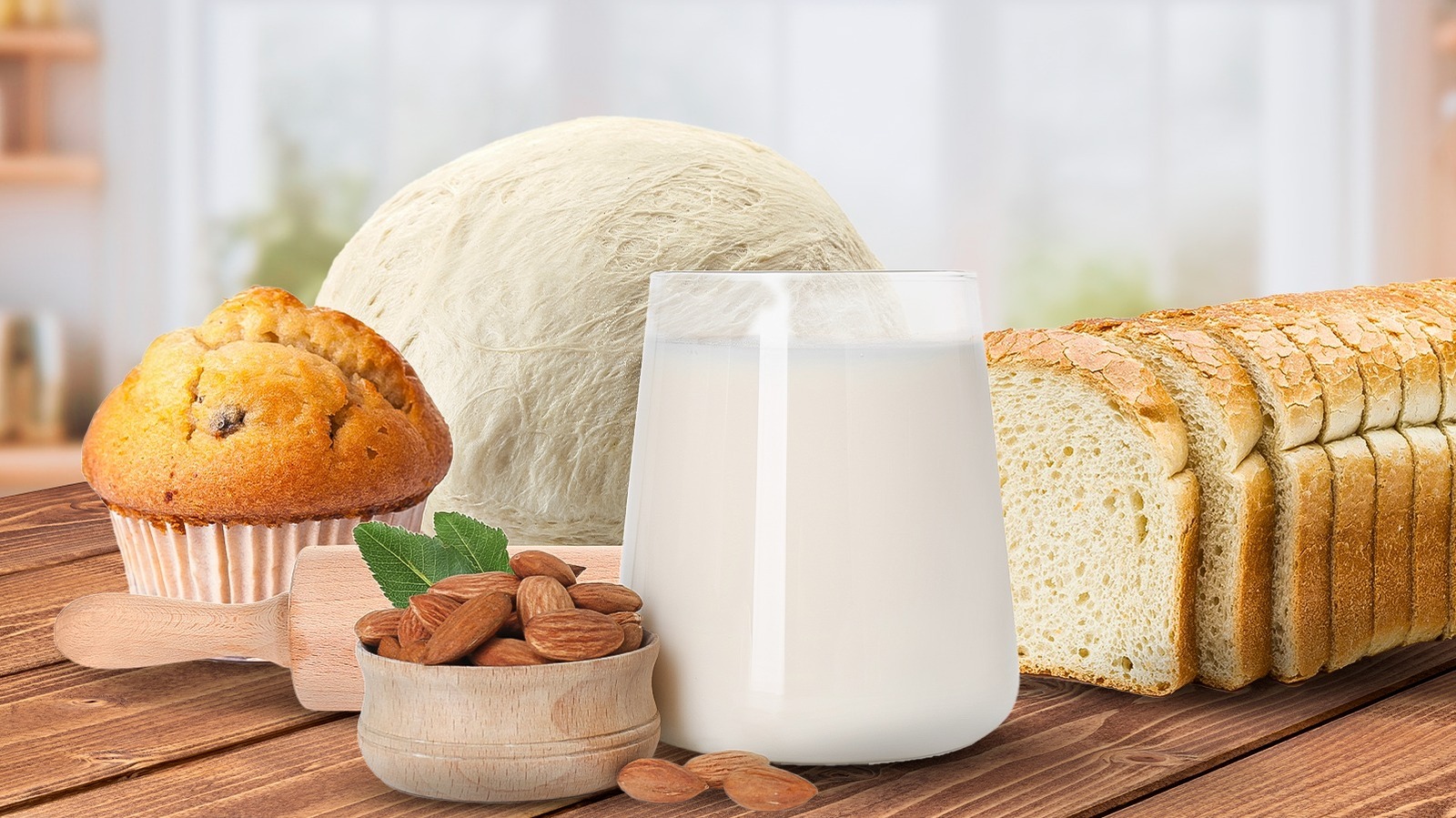Some of us are scientists, while others are artists. Artists tend to fare well in the cooking department, adding a pinch of this and a handful of that along the way. Scientists excel at baking, measuring diligently, and following precise directions. Baking really is a science, and when you decide to swap ingredients, it can affect the outcome of the recipe. Whether you’re lactose intolerant, vegan, an environmentalist, or just love to try new ingredients, almond milk may have made its way into your refrigerator, and even your recipes. For bakers, this means adapting and adjusting, as almond milk and cow’s milk are not scientifically the same. If you plan on making the swap, it’s best to do some research and follow tips for baking with almond milk before jumping in.
There are, however, plenty of reasons you might consider using almond milk in your baking in place of cow’s milk. For starters, more than ⅔ of the world’s population suffers from lactose malabsorption, which causes lactose intolerance. And folks are switching to non-dairy alternatives for other reasons, too, including health concerns, like low cholesterol and hormone-balancing diets. As a plant-based chef and recipe designer with a Plant-Based Nutrition Certification from Cornell University, I have worked with endless milk alternatives, and almond milk is one of my absolute favorites. Almond milk, being made from plants, contains zero cholesterol or lactose. It is naturally nutty and comes in quite a variety of flavors. It’s accessible, affordable, and is a wonderful alternative ingredient in your baking endeavors. However, when making the swap, there are a few tips you should consider.
Use it as a substitute for cow’s milk
Whenever making swaps while baking, it’s important to consider the ratio of dry to wet ingredients. Although we’d all love to dump in some extra flaxseed or coconut flour to alter the flavor, it’s important to note that the texture will also be affected. In addition, the chemistry aspect might be altered as well, leaving you with a flat, rubbery, or overly airy baked good. The same goes for wet ingredients. So, luckily, since cow’s milk and almond milk are both liquids that are generally of a similar consistency, you can use a clean 1:1 ratio for the swap.
The vast majority of the time, you will see little difference in the outcome of your baked good by making this even trade. This is why you should give almond milk a chance! However, because baking is a science and the protein, fat, and water content of almond milk is different from cow’s milk, adjustments might need to be made to a more finicky recipe. For your heartier recipes, like bran muffins, where the texture is a little denser and more forgiving, the difference may be noticeable. At the end of the day, whatever adjustments need to be made, you’ll want to start with that simple 1:1 ratio and go from there.
Add or reduce sugar
Not all almond milk is created equal. Not all cow’s milk is either, but it varies considerably less. When it comes to plant-based milk, there are no certainties about flavor, texture, or consistency. Some are watery, others creamy. Some nutty, others sweet. Cow’s milk is naturally sweet without any added ingredients like refined sugars. However, plant-based milks are typically not naturally sweet and include ingredients to boost the sweetness so they level up with cow’s milk.
Some brands have hit the nail on the head, balancing the flavors without creating a sugary product. Others are overly sweet, and it can throw off your recipe, especially when cooking savory dishes that call for milk. Luckily, desserts are a little more forgiving, but if you’re interested in producing the exact intended outcome in the sweetness department, you may have to adjust your other ingredients. Typically, I like to use unsweetened almond milk in my baked goods, and focus more on choosing a creamy, dense milk than worrying too much about the sugar content. If there is some added sugar, but it’s not detectable to your palate, then go right on measuring and pouring. If you’re finding that the almond milk is tasting noticeably sweet, then you’ll want to reduce the amount of sugar added to the recipe slightly to even the playing field. Even if your recipe calls for sweeteners that aren’t sugars, you can still reduce the sweet ingredient to find balance.
Avoid brands with additives
Because baking is a science, it’s always a little risky to make swaps and substitutions. If you must swap your cow’s milk for a non-dairy alternative, great chefs like Ina Garten prefer almond milk. And not just any almond milk, but an almond milk without too many additives, which are usually included to balance the texture and prevent separation. Folks craving plant-based alternatives to cow’s milk are often seeking a similar consistency and flavor, and these additives can help them get there. You may find gums like guar or xanthan in your almond milk as a thickener or stabilizer. Sunflower lecithin is another additive that helps to stabilize separation, preventing the need to shake it each time you use it. In addition, most processed foods these days contain preservatives to help extend shelf life.
These ingredients can affect your recipe, whether positively or negatively, so it’s important to be aware of them. Some brands proudly use minimal ingredients. Brands like Mooala or Elmhurst have options with two or three ingredients: almonds, water, and sometimes salt. If you’re having trouble locating a brand with limited ingredients, you could always make your own almond milk; I will cover how to do that later.
Be mindful of vanilla or other flavorings
It’s rare that we accidentally buy strawberry, chocolate, or vanilla cow’s milk. Dairy-free alternatives can be a little trickier if we aren’t used to the packaging or the brands. Plenty of plant-based milk brands, however, carry flavored milks. These are great for folks trying to transition to almond milk for the first time to mask the difference in flavor. However, you must be aware of exactly what kind of almond milk you are buying for your recipe.
Vanilla is the most common flavoring, and luckily, it tends to taste pretty good with most sweet treats. However, it’s important to note that it will affect the flavor of your baked good. If you’re baking something savory and it has a hint of vanilla, this might not be beneficial to the cohesion of the dish. For savory baked dishes, or any dish that won’t vibe with vanilla, steer toward an unflavored almond milk. For those sweet, vanilla-friendly dishes, pour away. If you are using vanilla almond milk in a recipe that already calls for vanilla, you may consider adding less extract, but I believe the more vanilla, the better.
Consider adding extra fat
Although there are plenty of reasons why I love almond milk, it does have one major downfall in the mouthfeel department. It is less fatty than cow’s milk, which not only gives it slightly less oomph but also changes the chemistry of the recipe when added to baked goods. Honestly, almond milk veers a little closer to skim milk territory, which isn’t typically recommended for baking. Whole milk works best, so the fattier the almond milk, the better.
If you can’t find a rich almond milk out there, or don’t have the patience to taste-test them all, then you can always add a touch of additional fat to your recipe. Try to choose neutral fats like vegetable oil or refined coconut oil. Even a drizzle of almond butter works, if it fits with the overall flavor. Just a small amount will do to help balance the dish and nudge it closer to the original recipe before the non-dairy swap. However, if you do have the patience to try a few different brands and find one that feels just as creamy as cow’s milk, make that your go-to. I find that brands with fewer ingredients have richer milk. There is no need to add thickeners when you’re using more almonds, so brands like Elmhurst tend to be ultra creamy. Some brands like Califia and Blue Diamond carry an “extra creamy” version of the standard almond milk, which would be worth a try in your baking.
Make your own almond milk for baking
When you’ve tried just about all the almond milk brands out there and you’re still not satisfied with the taste and texture, or the ingredients are just not up to your standard, then it’s time to take matters into your own hands. Although it may sound intimidating, making your own nut milk is actually quite simple, and rather satisfying at that.
First, gather your ingredients. Not all almonds will work to create creamy, neutral almond milk. So, focus on buying raw, unsalted almonds. This applies to any nut you’re planning to turn into nut milk. The raw nuts don’t have that roasted flavor that almond butter has, and instead are sweeter and milder. Save money by buying nuts in bulk and storing them in your freezer or refrigerator to extend their shelf life. For best results, let those almonds soak in water overnight in your refrigerator. If you’re pressed for time, four hours is enough to get them soft, or using hot water will speed up the process.
Next, drain and rinse the nuts, then blend them in a high-speed blender along with water. You’ll want to use a 1:4 ratio for nuts to water, but for a thicker homemade almond milk, use a 1:2 ratio. Blend the mixture until it’s creamy smooth, and then blend for 30 more seconds for good measure. Strain your concoction using a nut bag or cheesecloth, and enjoy. Vanilla and salt are optional ingredients to enhance flavor, and some folks like to add a little maple syrup for sweetness.
Select your brand carefully
As we know, not all almond milks taste the same. Honestly, I lost my faith in almond milk for a while after attempting to add a very watery and sweet brand to my morning coffee, which resulted in nothing but disappointment. Luckily, our Tasting Table team got busy and ranked popular almond milk brands from worst to best, and I couldn’t agree more with their selection. When it comes to baking, it’s important to choose a neutral-flavored almond milk with few ingredients and not too many additives or flavorings. It’s also important to keep consistency in mind when choosing alternative milk, as the variation is vast.
Flavor and mouthfeel are all about personal preference, but if you’re looking for a good almond milk for your baking, then avoid brands like Blue Diamond, which produces a nice neutral-flavored milk that is thick, but unfortunately, not as creamy as you’ll want to work with. Be mindful of its variation of flavors as well. Although So Delicious soy milk and non-dairy ice cream are some of my favorites, its almond milk just isn’t best for baking due to the thin and watery texture. Brands like Califa, Elmhurst, and Three Trees, however, tend to bake well. I would recommend targeting an extra creamy, unflavored, unsweetened option and giving it a taste. Next time you’re out, try another until you zero in on one that registers a similar mouthfeel as cow’s milk. The flavor will likely never read the same, but as long as it’s not overbearing to the recipe or an unpleasant flavor, your goal should be to find one that is relatively neutral.
Be mindful of nut allergies
Folks with nut allergies are typically pretty on top of reading ingredients or asking about the presence of nuts in baked goods. Baked goods are notorious for harboring surprise walnuts and pecans, and sometimes even pistachios. Now that nut milks are more popular, people with allergies have to be even more on top of their game. Make their job a little easier by letting them know. Do this if you have guests over, and especially if you have kids with friends running around your house. A verbal reminder will do, as long as you can chat with everyone.
Bringing your baked goods out of the house, however, opens the door for a greater chance that someone with a nut allergy might end up eating them and having a reaction. Although ultimately it is their responsibility to check in about foods they consume, it’s always a nice idea to bring a little card or sticky note that says “contains nuts” along with you. Consider this especially true if there will be children present, or if you are serving food to strangers, like at a bake sale.
Although not the top food allergy in adults, tree nuts are still a common allergen. It never hurts to go out of your way to keep people safe, especially with something that only takes a moment to do. Almond milk might be a curveball ingredient for the dish you’re creating, especially if it’s being used in place of cow’s milk, so do your due diligence and give everyone a heads up, even if you don’t think anyone is allergic.
You may have to adjust your bake time
While you can use a 1:1 ratio when replacing cow’s milk with almond milk, this doesn’t mean you are good to go. Almond milk, in general, has a higher water content than cow’s milk, which affects how it interacts with the other ingredients in your baked goods and how it cooks. Because it contains less protein than traditional milk, this throws another cog in the machine. As a result of these discrepancies, baked goods that contain almond milk may cook faster than baked goods with cow’s milk.
I would recommend setting your timer for a shorter period of time. This doesn’t mean you have to take the baked goods out sooner, but I would advise you to check on them. Look to see when your food begins to brown, or stick a fork in it to ensure the inside isn’t gooey. Go by touch and feel, and keep a close watch over your recipe as it nears the end of its cook time. The biggest concern with overcooking a baked good is that it will dry out and become less moist.
The color might be affected
Sometimes it’s important for our dishes to look aesthetically pleasing. Other times, as long as they look appealing, the details aren’t important. When it comes to baked goods, the color is typically not the most important aspect. However, if you are going for a very particular aesthetic, then it’s important to note that almond milk may alter the color. This is entirely because of the lower protein content in almond milk, making the result appear paler.
This lighter color may not be a bad thing, and the difference is not very noticeable. However, when you are using visual aids to let you know when your baked goods are done, the color difference could throw you off. If you’re feeling uncertain about reading visual cues with the color difference, consider other means of testing your baked goods. For some, you can do it by feel, others may require striking it with a toothpick to test that the inside is cooked. Either way, make a mental note that your recipe may not look exactly like it has in the past, but it will still be scrumptious and appetizing.
Avoid burning it
Have you had an almond milk cappuccino or latte out at a restaurant or cafe? If you frequently indulge, you may have noticed that the almond milk is burnt more frequently than you would care for. This isn’t necessarily because baristas steam almond milk longer — although they might give it more time in the frother to make it foam — but instead because almond milk is quicker to burn than cow’s milk. Therefore, if you are following a recipe that calls for scalding hot milk, you may want to consider using another non-dairy alternative.
When almond milk burns, it becomes bitter. And although almond milk is typically mild, this can alter the outcome of your dish. The bitterness shines through even in sweet recipes, so it’s best to slowly heat almond milk and remove it when it starts to steam. Because almond milk reacts differently to heat, it’s important to do your research and to follow tips for cooking with plant-based milk.





